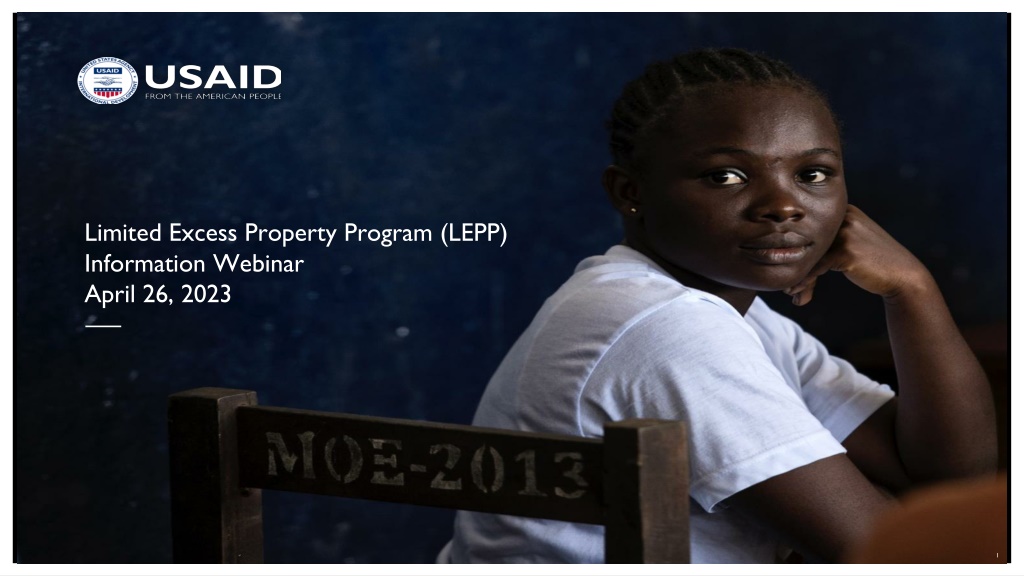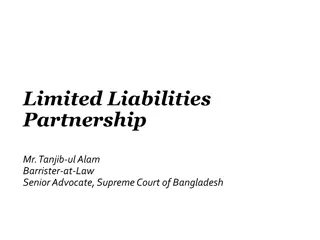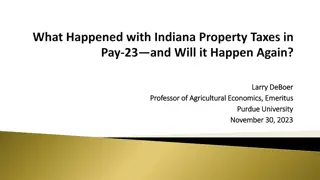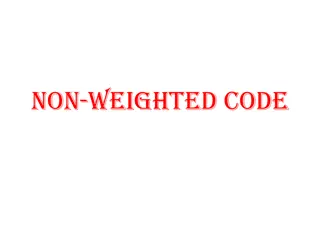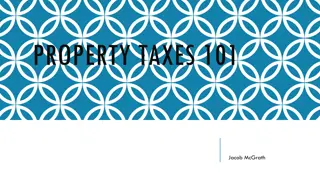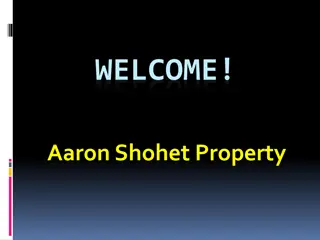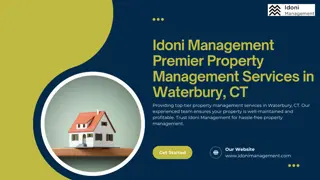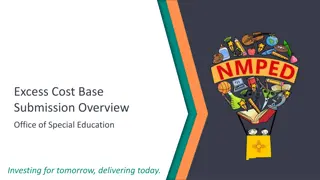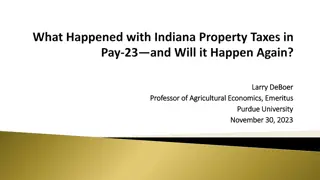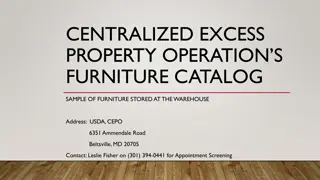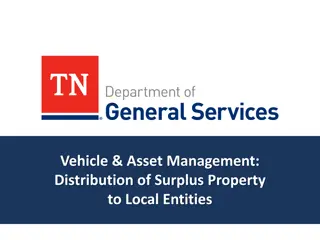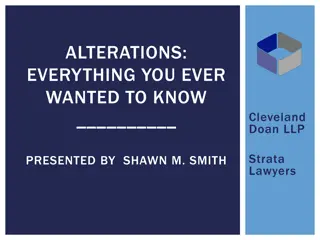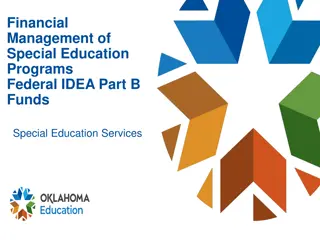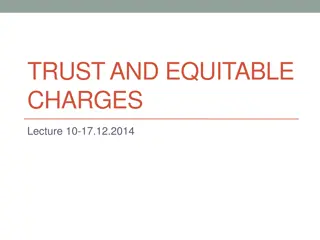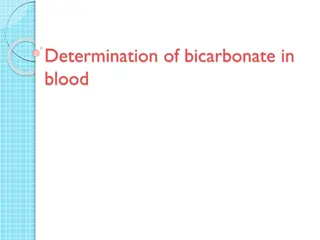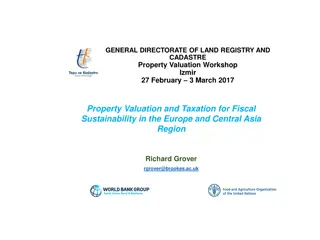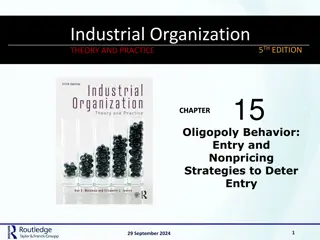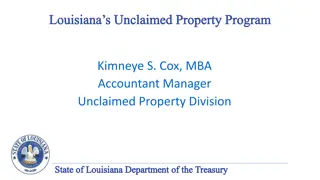Limited Excess Property Program (LEPP) Overview and Benefits
The Limited Excess Property Program (LEPP) is a unique initiative facilitating the transfer of US Government surplus property to Private Voluntary Organizations (PVOs) and USAID Missions for development projects. Managed by USAID's ASHA, LEPP provides access to quality surplus property, benefiting underdeveloped countries' medical systems among other sectors.
Download Presentation

Please find below an Image/Link to download the presentation.
The content on the website is provided AS IS for your information and personal use only. It may not be sold, licensed, or shared on other websites without obtaining consent from the author. Download presentation by click this link. If you encounter any issues during the download, it is possible that the publisher has removed the file from their server.
E N D
Presentation Transcript
Limited Excess Property Program (LEPP) Information Webinar April 26, 2023 1
Agenda Key Topics: Program Overview Program Benefits Program Highlights PVO Participation 607 Determination Process Requirements for Participation Q&A 3
Program Overview What is the Limited Excess Property Program? LEPP is a unique program that utilizes an innovative and cost-effective strategy to transfer millions of dollars worth of United States Government (USG) surplus property to Private Voluntary Organizations (PVOs) and USAID Missions for their development and humanitarian projects. LEPP has been in existence for over 30 years and is recognized as one of the oldest PVO programs at USAID. The program is managed by USAID s American Schools and Hospitals Abroad (ASHA), which is part of the Bureau for Development, Democracy, and Innovation s Local, Faith, and Transformative Partnerships (LFT) Hub. USAID has special authority under Section 607 of the Foreign Assistance Act to provide nongovernmental organizations who are approved as PVOs access to the U.S. General Services Administration (GSA) and the Defense Logistics Agency (DLA) Disposition Services excess property programs. 4
Program Overview How does the program work? The Limited Excess Property Program collaborates with the General Services Administration (GSA) and the Defense Logistics Agency (DLA) to provide PVOs and USAID Missions access to quality government surplus property. All surplus property is vetted prior to acquisition. The Department of Defense, Federal agencies, and State agencies are given priority when acquiring property for reuse. Although the property is vetted, there are still millions of dollars worth of Federal surplus property available to PVOs and USAID Missions on an annual basis. 5
Program Overview What categories of property are ordered through the program? Agriculture Equipment Appliances Bedding Clothing Computer Equipment Construction Equipment Dental Supplies and Equipment Furniture Generators Medical Supplies and Equipment Personal and Baby Items Safety and Rescue Equipment Tents and Tarpaulins Vehicles 90% of property acquired through the program is utilized to strengthen medical systems in underdeveloped countries. 6
Program Overview Does LEPP assist with the shipping costs of property? All costs associated with shipping are incurred at the expense of the PVO and USAID Mission. Additionally, USAID does not assist with custom clearances. The Federal government has special programs that can assist PVOs with shipping costs. These separate programs include; The Funded Transportation Program, Denton Program, and Ocean Freight Reimbursement Program. 7
Program Benefits What are the benefits of participating in this program? PVOs and USAID Missions have access to a variety of equipment and supplies that are scarce in developing countries. The capital saved by acquiring federal surplus property can be used to support other humanitarian aid and development programs. The program offers PVOs the opportunity to strengthen the capacity of their in-country partners by utilizing surplus property to support health, education, agricultural, and food security programs. 8
Program Highlights What are the major highlights of this program? Since 1987, LEPP has transferred close to a billion dollars worth of federal surplus property to more than 70 countries around the world. Over the past two years (in FY 21 and FY 22), nearly 70 million dollars worth of USG property was requisitioned through LEPP for use in development projects worldwide. In FY 22, more than 2.6 million people were served across the 110 partner programs/projects that use federal surplus property in countries in Africa, Asia, Eastern Europe, and Latin America and the Caribbean. Of these 110 partner programs/projects, 65 of them (representing 59% of the total) are using federal surplus property focused on women, children, and gender equity. 90 out of the 110 partner programs/projects (or 82%) engaged local stakeholders in the planning and implementation process of aid programs. In times of crisis, this work is even more critical. One illustration is LEPP s partnership with United Ukrainian American Relief Committee, and Mission Without Borders, which shipped $4,036,233 worth of equipment to Ukraine in FY 22 and FY 23 to address humanitarian needs resulting from Russia s war against Ukraine. Surplus property included medical equipment such as EKGs, resuscitators, stretchers, and syringes; cold weather clothing; bedding (sleep mats/bags/cots); and other supplies. 9
PVO Participation What are the steps to participate? The Request for Applications (RFA) will post to the Limited Excess Property Program (LEPP) website in late summer/early fall of 2023. The RFA will be announced via the LEPP website, USAID email listservs, LEPP Quarterly Newsletters, social media, and other forms of communication. In order to apply to LEPP, an organization must meet USAID's Private Voluntary Organization (PVO) self-certification criteria. Organizations applying to LEPP must complete and submit a PVO self-certification form as part of their application package. Completion of this form solely indicates that the organization meets the conditions as a PVO. Once self certification is complete, PVOs must participate in the Limited Excess Property Program s competitive application process. 10
PVO Participation To operate as a successful PVO in the program, organizations should: Build relationships with property custodians. Allocate funds and utilize resources to cover the shipping costs associated with surplus property. Assign designated personnel to manage the LEPP project. Have access to a warehouse facility to house, inspect, test, refurbish, and sanitize the surplus property. Work with an in-country partner that has a relationship with government entities. 11
PVO Participation What happens after PVOs are accepted into the program?
607 Determination Process The 607 Determination is a collaborative process: The 607 Determination process starts once a PVO receives their contingent acceptance into the program. Before a PVO is allowed to transfer excess property overseas, a collaborative determination is made by USAID/Washington and the USAID Mission. A PVO is not fully admitted into LEPP until their financials are vetted and they receive a signed 607 Determination from at least one Mission. 13
607 Determination Process USAID/Washington must determine the following: Furnishing the U.S. government excess property to (PVO) for use in connection with the project plan (PVO) submitted to LEPP is within the limitations of the Foreign Assistance Act and consistent with and in furtherance of the purposes of the part I of the Act; The designated end-user, (PVO), is responsible and able to effectively use and maintain such property; and The residual value, serviceability, and appearance of such property would not reflect unfavorably on the image of the United States and would justify the costs of packing, crating, handling, transportation, and other accessorial costs, and the residual value at least equals the total of these costs. 14
607 Determination Process The Mission Director or LEPP Point of Contact must determine the following: There is a need for the excess property in the quantity requested and the property is suitable for the requested purposes. That the Mission has no information that would suggest that the designated in- country partners are not able to effectively use and maintain such property. 15
Participating 607 Countries Africa Ethiopia Ghana Niger Timor-Leste Tanzania Eastern Southern Caribbean El Salvador Haiti Asia Europe Mongolia Philippines Albania Ukraine 16
Requirements for Participation PVO Self-Certification criteria: 17
Requirements for Participation Audit requirement: LEPP applicants must demonstrate sufficient financial capacity to participate in the program. Accordingly, applicants must provide audited financial statements with their applications per the following: U.S.-based PVOs (incorporated and headquartered in the United States). Audited financial statements prepared on an accrual basis in accordance with generally accepted accounting principles (GAAP) by an independent, certified public accountant (CPA). Financial statements must be in final form and for the most recently ended fiscal year or the prior fiscal year. Compilations, cash-basis, or modified audits will not be accepted. Non-U.S.-based PVOs (incorporated/chartered and headquartered/domiciled in a country other than the United States). Audited financial statements for the most recent fiscal year prepared on an accrual basis in accordance with GAAP or generally accepted accounting standards for the PVO s country of domicile by an independent CPA. Financial statements must be in final form for the most recently ended fiscal year or the prior fiscal year and translated into English. Compilations, cash-basis, or modified audits will not be accepted. Note: Submission of audited financial statements is an ongoing, annual requirement for LEPP participation. 18
Requirements for Participation Do No Harm policy: LEPP s monitoring & evaluation process requires staff to ascertain that participants have systems in place to ensure that Federal property acquired through the program does not harm or create negative consequences in the local institutions and communities where it is deployed. Accordingly, LEPP requires all PVO participants to have a Do No Harm (DNH) policy and a DNH procedure in place prior to the transfer of excess property. Required documentation includes the following: A DNH policy that expresses the organization s commitment to do no harm with respect to recipients of LEPP-acquired property and states that the PVO will use all appropriate means necessary to ensure that its transfer and use of the property will not impair local financial, environmental or physical well-being; create disincentives for local production; play into systems for corruption; foster relationships of dependency; or reflect unfavorably on the United States. A DNH procedure that outlines a clear, documentable process for how the PVO monitors, identifies, and resolves concerns through appropriate controls to ensure no harm will be caused by the PVO or in-country partners in conjunction with the deployment or distribution of property acquired through LEPP. -This requirement should be completed after the PVO is accepted into the program. -The full LEPP Do No Harm requirement document will be available with the RFA. -LEPP will hold an information webinar on the DNH requirement following participant selection. 19
For more information on LEPP: Visit: https://www.usaid.gov/local-faith- and-transformative- partnerships/limited-excess-property- program 20
Q&A Questions & Answers 21
